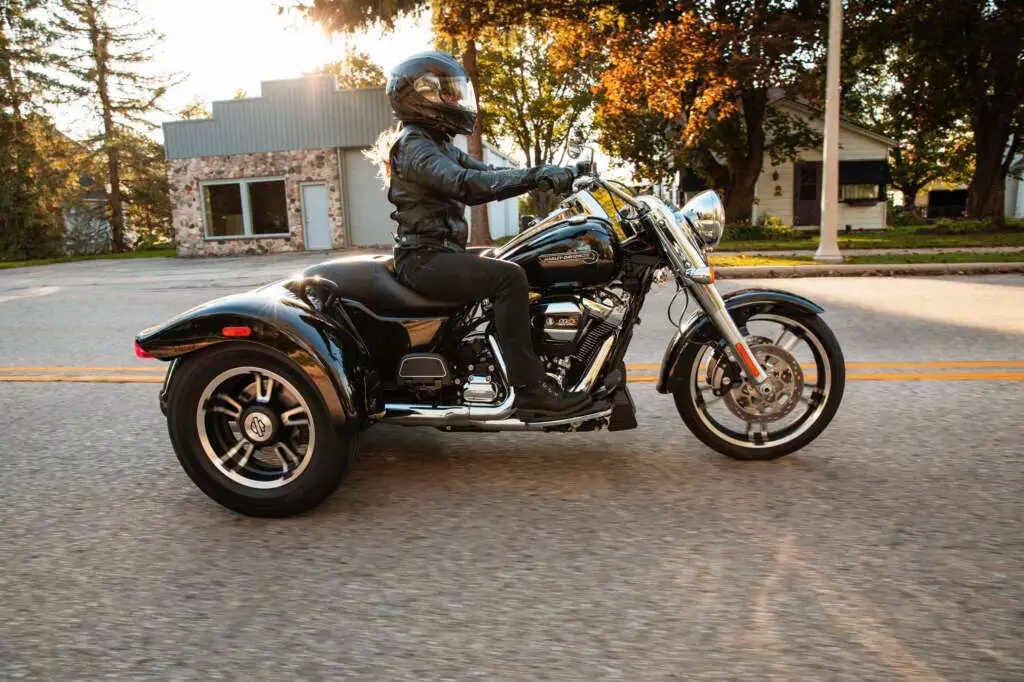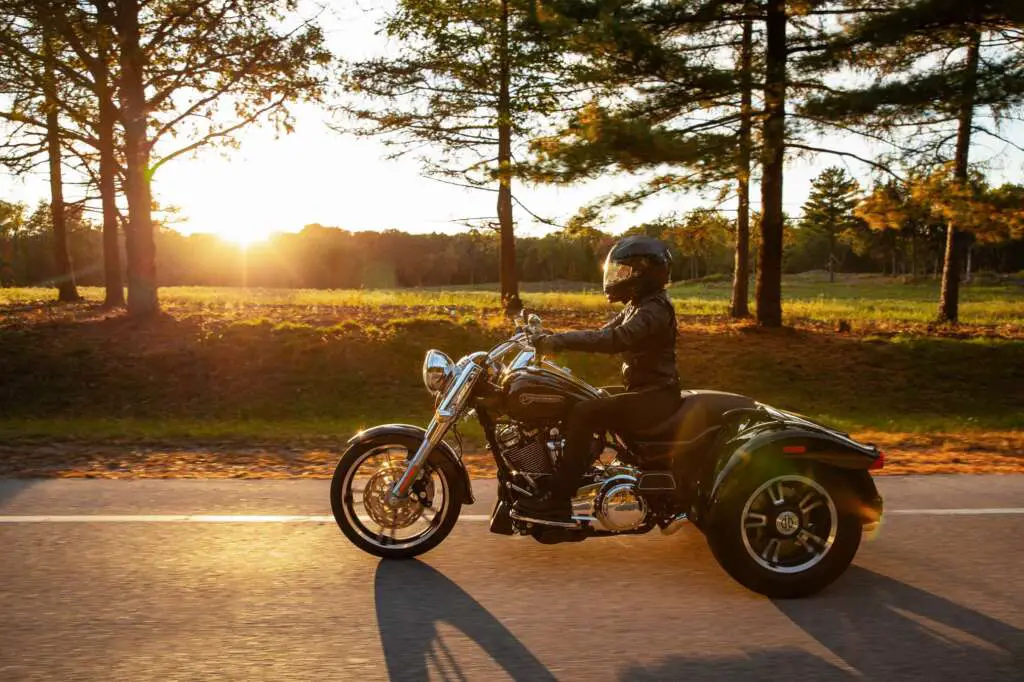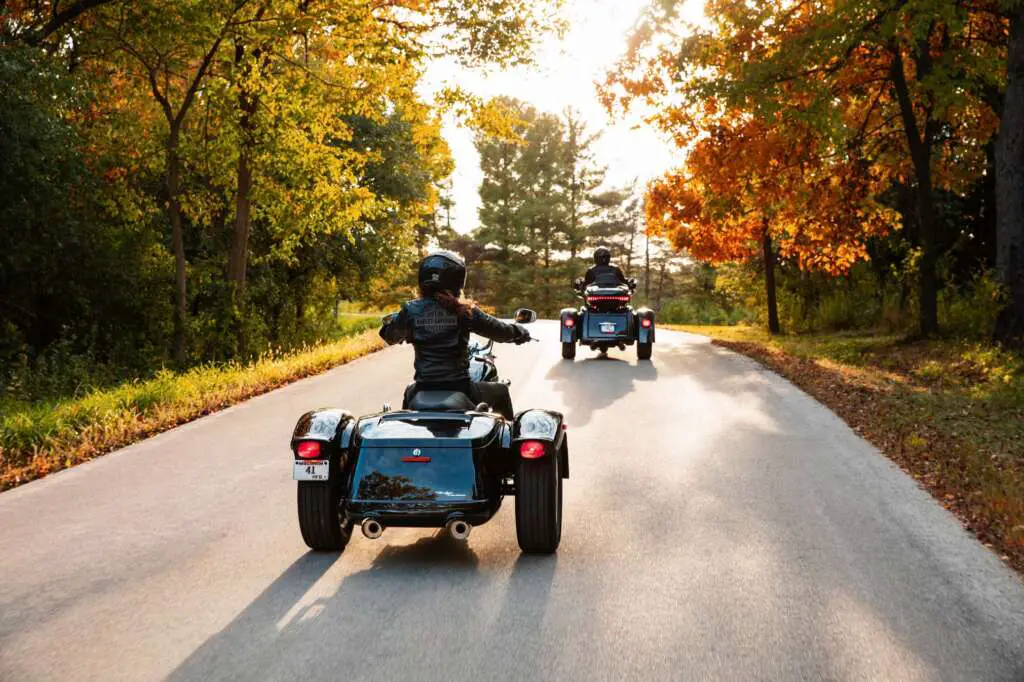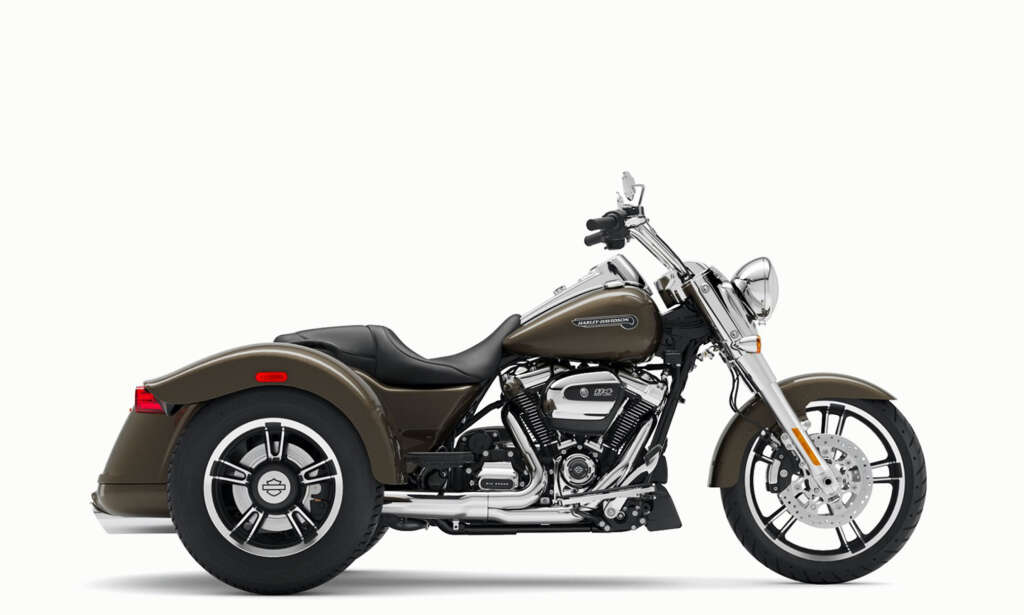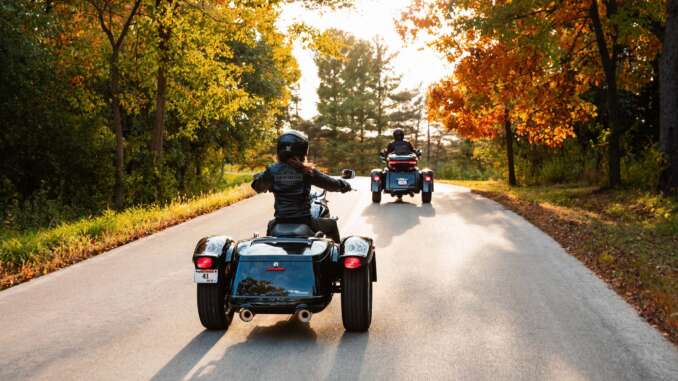
2021 Harley-Davidson Tri Glide Freewheeler: HARLEY-DAVIDSON ENHANCED.
Introducing the 2021 Harley-Davidson Tri Glide Freewheeler…
The Freewheeler has all-new braking enhancements like cornering enhanced Reflex linked brakes with ABS and traction control. Classic styling details, like bobtail fenders, slash cut pipes, 12-inch mini apes and Enforcer aluminum wheels. There’s enough cargo space to hold two full-face helmets plus extra gear. Power is plentiful, thanks to a Milwaukee-Eight 114 V-Twin engine. Dual bending valve 49mm front forks and easily adjustable rear suspension make the ride smooth.
Trike – Roll with confidence, comfort, and head-turning custom style on three wheels.
A stripped-down hot rod cruiser with raw attitude and the confidence of three wheels.
2021 Harley-Davidson Tri Glide Freewheeler Totalmotorcycle.com Key Features
THIS IS THE RIGHT BIKE FOR
Riders looking to customize their dream trike
Bold styling with bobtail fenders and Mini-Ape bars
Milwaukee-Eight® 114 V-Twin engine and Enforcer wheels
Upright riding position
Floorboards
Passenger seat
Trunk
RDRS standard
HARLEY-DAVIDSON® RDRS SAFETY ENHANCEMENTS DESIGNED TO BOOST MOTORCYCLE RIDER CONFIDENCE
Motorcycle-Specific Technology Matches Performance to Available Traction
Harley-Davidson® RDRS Safety Enhancements (formerly known as RDRS) is a collection of technology designed to enhance rider confidence during unexpected situations or poor road conditions. RDRS Safety Enhancements are designed to match motorcycle performance to available traction during acceleration, deceleration and braking, in a straight line or while in a turn. The systems are electronic and utilize the latest chassis control, electronic brake control and powertrain technology.
“RDRS Safety Enhancements are technologies developed by Harley-Davidson and designed to make motorcycling more intuitive,” said VP Marketing Theo Keetell. “Our intent is to assist riders of every skill level in an unanticipated moment when electronic intervention may react more quickly, and with more precision, than our own reflexes can react. A situation that activates an RDRS Safety Enhancement may be rare, but if it occurs, this technology may be invaluable.”
Introduced for many 2020 Harley-Davidson® motorcycles, RDRS Safety Enhancements are standard on all 2021 Harley-Davidson CVO™, Tri Glide® Ultra, Freewheeler®, and LiveWire® models. RDRS Safety Enhancements are optional on all 2021 Touring models in the U.S. The RDRS Safety Enhancements are bundled together, except where noted.
Important Note: Available traction is determined by the road/tire interface. RDRS Safety Enhancements on motorcycles are only able to adjust brake pressure or powertrain torque in an attempt to keep the forces at the tire from exceeding available grip. These technologies do not have the ability to increase grip, or to intervene when the rider has not made a brake or throttle application (e.g. coasting through a corner with the clutch disengaged). RDRS Safety Enhancements on motorcycles do not have the ability to directly influence vehicle direction. This is a key difference between motorcycle RDRS Safety Enhancements and automotive stability control. The rider is ultimately responsible for speed, steering and path corrections.
Cornering Enhanced RDRS Safety Enhancements
Some RDRS Safety Enhancements may be “cornering enhanced,” technology that is motorcycle-specific and a key difference between RDRS Safety Enhancements and automotive traction/stability control systems. Harley-Davidson motorcycles equipped with RDRS Safety Enhancements have an inertial measurement unit, or IMU, that measures and reports the lean angle of two-wheel motorcycles, or the lateral acceleration of a Trike (three-wheel motorcycle), as it navigates a turn. Because many motorcycles have different size front and rear tires, when the motorcycle leans into a turn the wheels begin to rotate at slightly different speeds. The tire traction patch – the part of the tire actually touching the pavement – also changes as the motorcycle leans in a turn. Cornering enhanced technology takes this into account and for optimal performance intervenes differently when the motorcycle is leaned compared to when the motorcycle is upright.
RDRS Safety Enhancements
Cornering Enhanced Electronic Linked Braking (C-ELB)
This technology applies braking effort to both wheels when the rider uses either the hand lever (front) or foot pedal (rear) brake control, which can help many riders achieve better braking performance. The C-ELB system provides more responsiveness and allows for more balanced front and rear braking under a wide variety of brake applications. The system provides more linking when the rider is applying heavier braking and reduces or eliminates linking for light braking and low speeds. When linked, applying the front brake lever alone will cause the system to also dynamically apply an amount of braking to the rear. Applying the rear brake pedal alone will cause the system to also apply an amount of braking to the left front caliper. C-ELB takes into account the motorcycle lean angle or Trike lateral acceleration. C-ELB will alter the proportioning of brake pressure between the front and rear brakes when braking while cornering in an attempt to improve the ability of the bike to maintain the rider’s intended path.
This technology is standard on all 2020-later CVO™ models and optional on most 2020 Touring models.
Cornering Enhanced Antilock Braking System (C-ABS)
ABS is designed to prevent the wheels from locking under braking and helps the rider maintain control when braking in a straight-line, urgent situation. ABS operates independently on front and rear brakes to keep the wheels rolling and prevent uncontrolled wheel lock. Cornering Enhanced Antilock Braking System (C-ABS) is a variant of ABS that takes into consideration the lean angle of a two-wheel motorcycle, or the lateral acceleration of a Trike model. The brake pressure required to limit wheel slip when cornering is typically lower than the pressure required under straight line operation.
This technology is standard on 2020-later LiveWire and CVO models and optional on most 2020-later Touring models.
Cornering Enhanced Traction Control System (C-TCS)
The Cornering Enhanced Traction Control System (C-TCS) is designed to prevent the rear wheel from excessive spinning under acceleration when going straight or cornering. C-TCS can improve rider confidence when available traction is compromised by wet weather, a sudden unanticipated change in the surface, or when riding on an unpaved road. The rider may select one of two traction control modes: Standard Mode is optimized for dry surfaces; Rain Mode is optimized for wet surfaces. The system can also be turned off. The action of C-TCS is also tailored when cornering based on lean angle.
This technology is standard on all 2020-later LiveWire and CVO models and optional on most 2020-later Touring models.
Drag-Torque Slip Control System (DSCS)
Cornering Enhanced Drag-Torque Slip Control System (C-DSCS)
Drag-Torque Slip Control (DSCS) is designed to reduce excessive rear-wheel slip under deceleration, which typically occurs when the rider makes an abrupt down-shift gear change or decelerates abruptly on wet or slippery road surfaces. When DSCS detects excessive rear wheel slip under deceleration it will adjust engine torque delivery to better match rear-wheel speed to road speed. On models equipped with C-DSCS the action of DSCS may be tailored when cornering, based on detected lean angle (two-wheel motorcycles) or lateral acceleration (Trike models).
DSCS is standard on all 2020-later CVO models and optional on most 2020-later Touring models. C-DSCS is standard on all 2020-later Trike models.
Vehicle Hold Control (VHC)
Vehicle Hold Control (VHC) applies and holds brake pressure when activated and prevents the motorcycle from rolling after the rider has released the brake controls. The primary function of VHC is to prevent the motorcycle from rolling when it is stopped, for example at a stop sign on a hill, in stop-and-go traffic on a slope, or on a steep decline out of a parking structure. VHC is designed to make it easier to ride away with confidence by minimizing the number of controls needed to pull away smoothly. The system applies brake pressure until the rider actuates the throttle and clutch to pull away. VHC may also be engaged when the motorcycle is stopped on a flat surface if the rider wants to maintain position without applying pressure to a brake control.
The rider activates VHC by momentarily applying extra pressure to either the front-brake hand lever or the rear-brake foot control after the motorcycle has come to a complete stop. If rider brakes very hard to a stop, and holds the brake pressure after stopping, VHC may also set without any added squeeze. A VHC indicator light will illuminate to confirm that the rider has activated VHC, and the ABS system will hold brake pressure after the rider releases the brake control. VHC is disengaged automatically as the rider begins to pull away from a stop, or if the rider applies and releases either brake control.
VHC is not to be used as a parking brake, so it will also disengage if the rider lowers the side stand (on models with a side-stand sensor, not a feature in all markets) or shifts into neutral on models without a side-stand sensor, or if the engine is turned off. In most situations after five minutes the indicator light will flash and the VHC will release if there is no rider action.
This feature is standard on 2020-later CVO™ models and optional on most 2020-later Touring models. VHC is not intended as a substitute for a parking brake in any situation.
Tire Pressure Monitoring System (TPMS)
TPMS alerts the rider to low tire air pressure. Maintaining proper tire air pressure is important both for vehicle performance and tire life. The TPMS displays current front and rear tire pressure on the Boom!™ Box GTS screen (or on the odometer on Road King® models) and displays an indicator to alert the rider when tire pressure is low, and the pressure should be checked.
TPMS is part of the collection of RDRS Safety Enhancements and is also available as a stand-alone accessory through Harley-Davidson® Genuine Motor Parts & Accessories for 2020-later Touring models (except Japan) equipped with original equipment or accessory wheels that accept a TPMS sensor.
RDRS Safety Enhancements for Trike Models
Harley-Davidson® Freewheeler® and Tri Glide® Ultra models are equipped with Trike-specific RDRS Safety Enhancements. These include Cornering Enhanced Electronic Linked Braking (C-ELB), Cornering Enhanced ABS (C-ABS), Cornering Enhanced Traction Control System (C-TCS) and Cornering Enhanced Drag-Torque Slip Control System (C-DSCS). The CVO™ Tri Glide® model adds TPMS to the Trike-specific RDRS Safety Enhancements.
2021 Harley-Davidson Tri Glide Freewheeler Totalmotorcycle.com Features and Benefits
MILWAUKEE-EIGHT® 114 ENGINE
The most displacement in standard H-D® Touring models. You get 114 cubic inches of passing and horizon-chasing power.
REFLEX™ LINKED BREMBO® BRAKES WITH STANDARD ABS
Designed to help prevent the wheels from locking under braking to assist the rider in maintaining control when braking in a straight-line. ABS operates independently on front and rear brakes to keep the wheels rolling and help prevent uncontrolled wheel lock in urgent situations.
HIGH PERFORMANCE SUSPENSION
Premium Harley-Davidson touring suspension technology is calibrated specifically for Trike models, delivering a smooth and responsive ride.
MINI-APE HANGER BARS
The 12-inch Mini-Ape hanger bars on the Freewheeler® model are the tallest rise you can get from an OE manufacturer. They pull the hand controls back toward the rider, and reduce the force it takes to turn the front wheel for easy riding and easy handling.
BOBTAIL REAR FENDERS
The pair of Harley-Davidson® bobtail rear fenders give the bike classic cruiser lines and styling details.
CHROME SLASH CUT MUFFLERS
The Milwaukee-Eight® 114 engine puts its exhaust note out to the world through these chrome slash down pipes.
ENFORCER CAST ALUMINUM WHEELS
There’s an Enforcer front wheel leading the way, and you’ve got two more to match in the back. Up front, the brake rotors have been redesigned to show off more of the premium custom look of the wheels.
7-PIECE NACELLE
A classic style chrome headlight nacelle is tucked tight against the frame and forks for a tighter, smaller look. It also accommodates a clean-looking windshield mounting system.
UNIQUE TRUNK SYSTEM
It’s a one-of-a-kind design that opens left to right (with one hand) and extends the entire length of the body for a clean look. Enough cargo space to easily accommodate two full-face helmets.
STEERING HEAD AND FRONT FORKS
The responsiveness is dialed in with a stiff front end and 49mm front forks, plus a steering damper that controls feedback from the road.
Custom touring style and easy handling features that lets you roll with confidence for longer. It’s everything you love about H-D Touring, just on three wheels. The new premium touring front and rear suspension is calibrated specifically for trike models. Easy tool-free preload adjusting, new cornering enhanced linked brake system with ABS and Traction Control, and luxurious seating put you in control of an unmatched ride. Incorporates an Antilock Braking System (ABS) and Traction Control System (TCS) that work together to provide enhanced cornering capability. In addition, the Milwaukee-Eight 114 engine gives you passing and horizon-chasing power.
2021 Harley-Davidson Tri Glide Freewheeler – Totalmotorcycle.com Specifications/Technical Details
US MSRP Price: $27999 to $29599 USD
Canada MSRP Price: $34295 to $36395 CDN
Europe/UK MSRP Price: £27995 to 29035 GBP (On The Road inc 20% Vat)
USA PRICING
VIVID BLACK
$27,999
COLOR
$28,499
CUSTOM COLOR
$29,599
ABS OPTION
Standard
SECURITY OPTION
Standard
CRUISE CONTROL OPTION
Standard
CALIFORNIA EMISSIONS
$200
FREIGHT
$856
Canadian PRICING
VIVID BLACK
$34,295
COLOUR
$35,295
CUSTOM COLOUR
$36,395
ABS OPTION
Standard
SECURITY OPTION
Standard
CRUISE CONTROL OPTION
Standard
UK PRICING
VIVID BLACK
£27,995
COLOUR
£28,345
CUSTOM COLOUR
£29,035
SECURITY OPTION
Standard
CRUISE CONTROL OPTION
Standard
| Model | FLRT Freewheeler® | Notes |
| Dimensions | ||
| Length | 103 in. (2,615 mm) | |
| Overall Width | 55.3 in. (1,405 mm) | |
| Overall Height | 45.3 in. (1,150 mm) | |
| Seat Height, Laden | 26.2 in. (665 mm) | 2 |
| Seat Height, Unladen | 27.6 in. (700 mm) | |
| Ground Clearance | 4.9 in. (125 mm) | |
| Rake (steering head) (deg) | 26 | |
| Fork Angle (deg) | 32.2 | |
| Trail | 3.96 in. (101 mm) | |
| Wheelbase | 65.7 in. (1,670 mm) | |
| Tires, Type | Dunlop® Harley-Davidson Series, bias blackwall front and radial blackwall rear | |
| Tires, Front Model | D408F | |
| Tires, Front Specification | MT 130/60B19 M/C 61H | |
| Tires, Rear Model | Signature | |
| Tires, Rear Specification | P205/65R15 | |
| Fuel Capacity | 6 gal. (22.7 l) | |
| Reserve Fuel Capacity, Fuel Injection (warning light) | 1 gal. (3.8 l) | |
| Oil Capacity (w/filter) | 5 qt. (4.7 l) | |
| Transmission Capacity | 1.1 qt. (1.0 l) | |
| Primary Chain Case Capacity | 1.1 qts. (1.0 l) | |
| Coolant Capacity | N/A | |
| Weight, As Shipped | 1,085 lb. (492 kg) | |
| Weight, In Running Order | 1,118 lb. (507 kg) | |
| Gross Vehicle Weight Rating | 1,700 lb. (771 kg) | |
| Gross Axle Weight Rating, Front | 511 lb. (232 kg) | |
| Gross Axle Weight Rating, Rear | 1,188 lb. (539 kg) | |
| Luggage Capacity -Volume | 2 cu ft (0.06 m3) | |
| Engine | ||
| Engine | Milwaukee-Eight® 114 | |
| Valves | Pushrod-operated, overhead valves with hydraulic, self-adjusting lifters; four valves per cylinder | |
| Bore | 4.016 in. (102 mm) | |
| Stroke | 4.5 in. (114 mm) | |
| Displacement | 114 cu in (1,868 cc) | |
| Compression Ratio | 10.5:1 | |
| Fuel System | Electronic Sequential Port Fuel Injection (ESPFI) | 3 |
| Air Cleaner | Paper, washable | |
| Exhaust | Shorty slash down-style chrome finish mufflers | |
| Lubrication System | Pressurized, dry-sump with fan-assisted oil cooler | |
| Drivetrain | ||
| Primary Drive | Chain, 34/46 ratio | |
| Final Drive | Belt, 30/70 ratio | |
| Clutch | Mechanically actuated 10 plate, wet Assist & Slip | |
| Transmission | 6 Speed Cruise Drive | |
| Gear Ratios (overall) 1st | 10.534 | |
| Gear Ratios (overall) 2nd | 7.302 | |
| Gear Ratios (overall) 3rd | 5.423 | |
| Gear Ratios (overall) 4th | 4.392 | |
| Gear Ratios (overall) 5th | 3.741 | |
| Gear Ratios (overall) 6th | 3.157 | |
| Chassis | ||
| Frame | Mild steel, square-section backbone with twin downtubes | |
| Swingarm | Mild steel, rectangular tube sections with plate junctions; MIG welded | |
| Front Fork | 49mm dual bending valve | |
| Rear Shocks | Hand-adjustable emulsion rear suspension | |
| Wheels, Front Type | Enforcer Cast Aluminum | 4 |
| Wheels, Front Width | 3.5 in. (89 mm) | |
| Wheels, Front Height | 19 in. (483 mm) | |
| Wheels, Rear Type | Enforcer Cast Aluminum | 4 |
| Wheels, Rear Width | 5.5 in. (140 mm) | |
| Wheels, Rear Height | 15 in. (381 mm) | |
| Brakes, Caliper Type | Front: 32mm 4 piston fixed, Rear: floating 36mm piston integrated park brake | |
| Brakes, Rotor Type | Dual floating rotors (front), fixed rotor (rear) | |
| Brakes, Front Diameter | 11.8 in. (300 mm) | |
| Brakes, Front Thickness | 0.2 in. (5.1 mm) | |
| Brakes, Front is dual | Yes | |
| Brakes, Rear Diameter | 10.6 in. (270 mm) | |
| Brakes, Rear Thickness | 0.24 in. (6 mm) | |
| Brakes, Anti-Lock Braking System (ABS) | Standard | |
| Suspension Travel, Front | 4.6 in. (117 mm) | |
| Suspension Travel, Rear | 3 in. (76 mm) | |
| Performance | ||
| Engine Torque Testing Method | J1349 | |
| Engine Torque | 122 ft-lb (165 Nm) | 5 |
| Engine Torque (rpm) | 2,250 | |
| Lean Angle Testing Method | N/A | |
| Lean Angle, Right (deg.) | N/A | |
| Lean Angle, Left (deg.) | N/A | |
| Fuel Economy Testing Method | Estimated City/Hwy | |
| Fuel Economy | 43 mpg (5.5 l/100 km) | 6 |
| Electric | ||
| Battery | Sealed, maintenance-free, 12V, 28-amp/hour, 405 cca (per battery Council International Rating) | |
| Charging | Three Phase, 48-amp system (600W@13V, 2000 rpm, 625W max power @ 13V) | |
| Starting | 1.6kW electric with solenoid shift starter motor engagement | |
| Lights (as per country regulation), Headlamp | Dual halogen | |
| Lights (as per country regulation), Tail/Stop | Incandescent | |
| Lights (as per country regulation), Front Signal Lights | Incandescent | |
| Lights (as per country regulation), Indicator Lamps | High beam, running lights, battery, neutral, low oil pressure, engine diagnostics, cruise control, security system, gear indicator, low fuel warning, reverse, park brake | 7 |
| Lights, Rear Turn Signals | Incandescent | |
| Gauges | Speedometer, fuel gauges; display features odometer, trip A, trip B, range to empty, and gear indicator | |
| Auxiliary Lamps | N/A | |
| Electric Power Outlet | N/A | |
| GPS System | N/A | |
| Reverse Gear | Electric reverse actuated by handlebar mounted hand controls. | |
| Warranty And Service | ||
| Warranty | 24 months (unlimited mileage) | 8 |
| Service Interval | First 1,000 miles (1,600 km), every 5,000 miles (8,000 km) thereafter | 9 |
Footnotes1Vehicles depicted may differ from vehicles manufactured and delivered. Specifications and prices listed may differ from specifications and prices of vehicles manufactured and delivered. All product descriptions (including depictions, specifications, dimensions, measurements, ratings and competitive comparisons) are based on available information at the time of publication. Although such descriptions are believed correct, errors and changes can occur and complete accuracy cannot be guaranteed. Harley-Davidson may make changes at any time to prices and specifications, and may change or discontinue models, without notice and without incurring any obligation. Attention: Vehicles in the configurations shown and many of the accessories described in this catalog may not be available for sale or use in some locations. Please check with your dealer for complete product details and the latest information. All models feature 6-speed transmission (VRSC™ models and Sportster® models are 5-speed) and carbon fiber belt final drive; multi-plate clutch with diaphragm spring in oil bath; and 2-year unlimited mileage warranty. 2Measurement reflects 180 lb. (81.7 kg) operator weight. 3Recommended 91 octane or higher fuel (R+M)/2. 4Standard and optional wheels may vary by country and region. 5Values shown are nominal. Performance may vary by country and region. 6The combined fuel economy numbers were derived using a combination of estimated city and highway values. Fuel economy estimates are derived from US EPA exhaust emission certification data on a sample motorcycle from the corresponding family under ideal laboratory conditions. Your actual fuel economy will vary depending on your personal riding habits, road and driving conditions, vehicle condition and maintenance, tire pressure, vehicle configuration (parts and accessories), and vehicle loading (cargo, rider and passenger weight). Break-in mileage may vary. 7North America security system includes immobilizer; outside North America the security system includes immobilizer and siren. 8See motorcycle owner’s manual for complete details. 9Inspections of certain systems and components are required at 2,500 mile (4,000 km) intervals. See Owner’s Manual for full details.
Manufacturer Specifications and appearance are subject to change without prior notice on Total Motorcycle (TMW).


